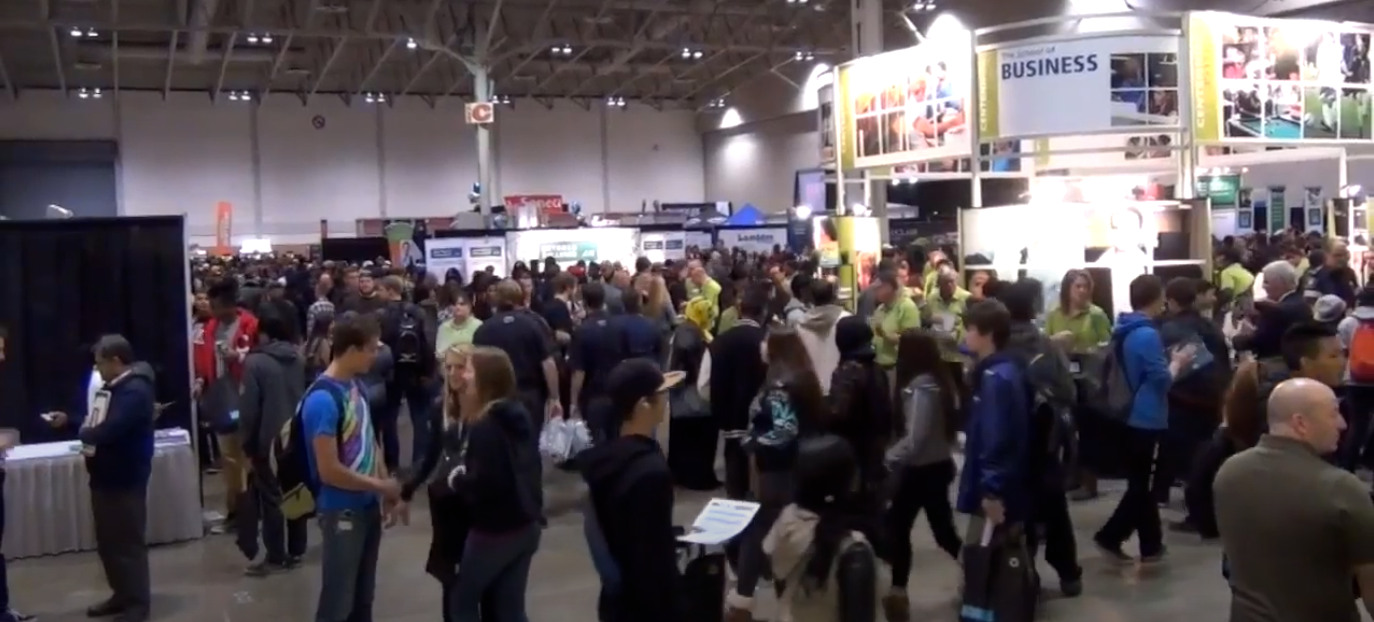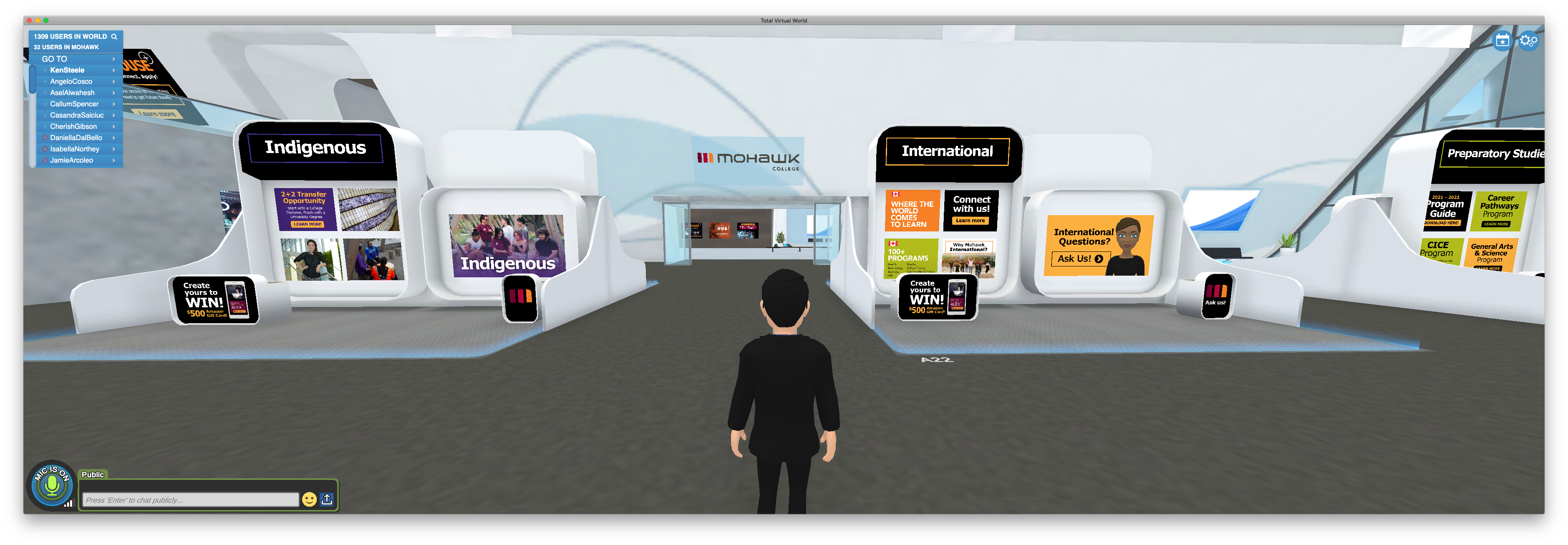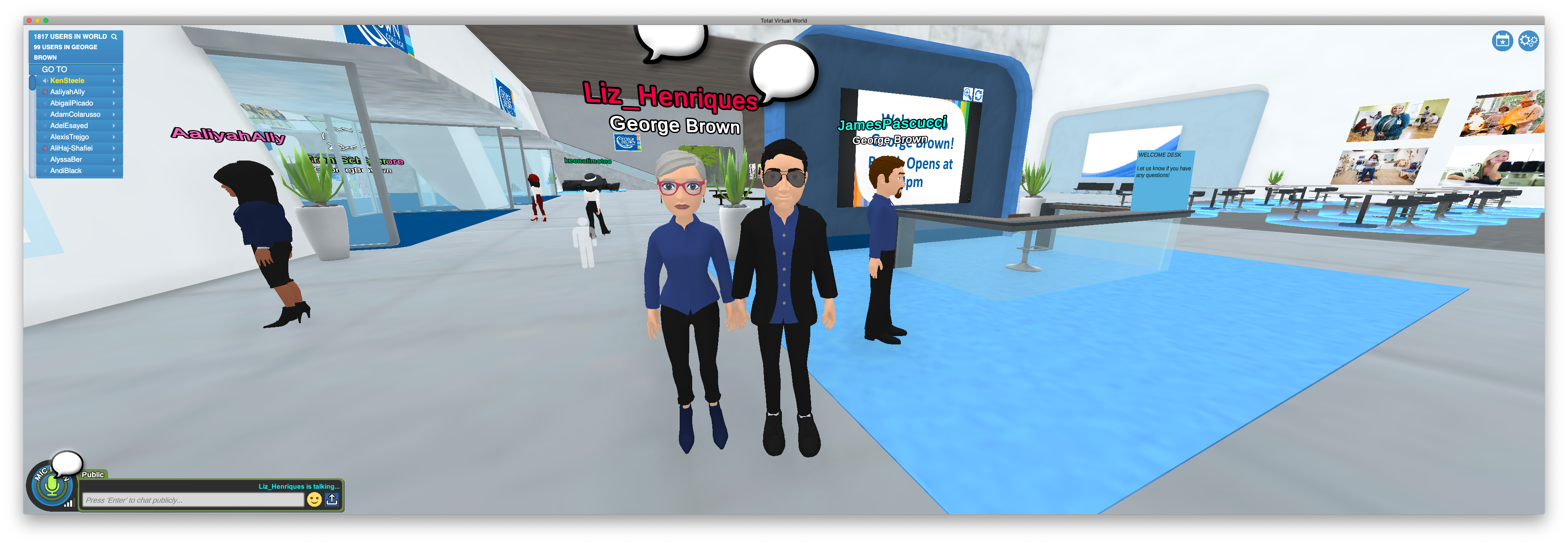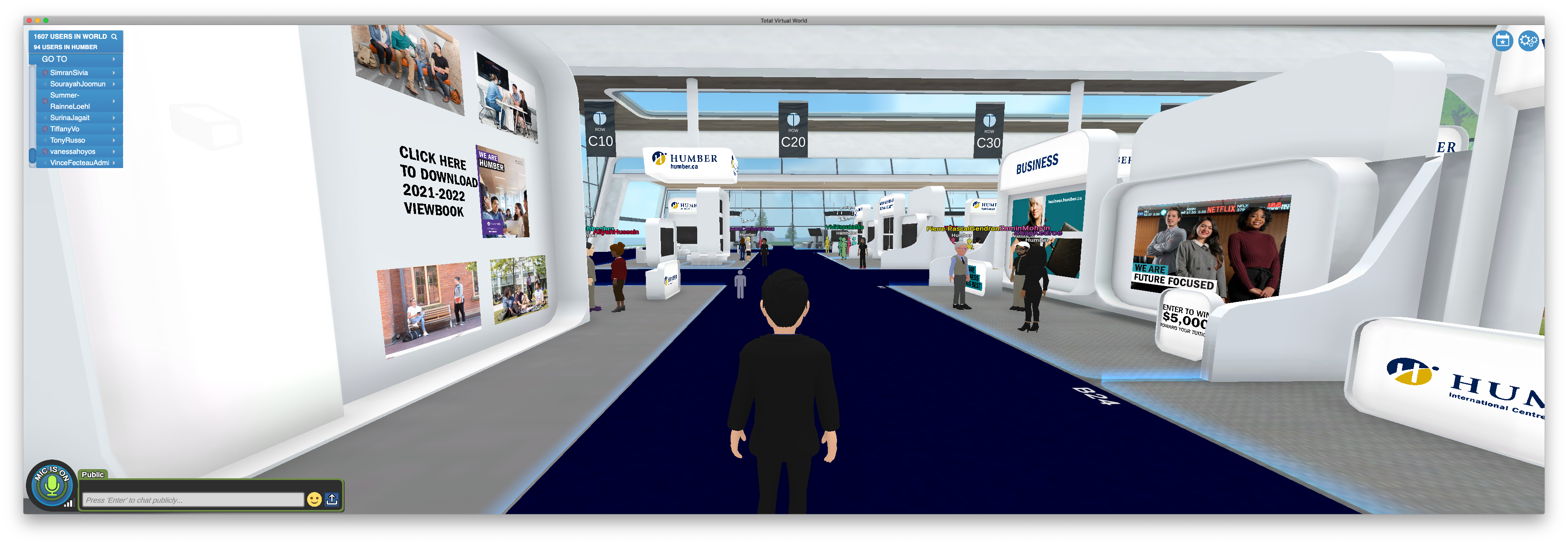Eduvation Blog
Wednesday, November 4, 2020 | Category: PSE Fairs
2020 Ontario College Fair goes Virtual
Ken Steele, on location at the 2020 Ontario College Virtual Fair
Normally, the Ontario College Information Fair (OCIF) fills an exhibit hall at Toronto’s Exhibition Place with thousands of prospective students, parents, and recruiters from Ontario’s 24 public colleges. It’s a highlight of the recruitment cycle, and one of North America’s largest higher ed fairs.
I’ve blogged about the OCIF in 2007 and 2009, and in 2013 I produced a 22-min video which really captures the energy of the live event. (It was my second-ever podcast, but still not too bad!) Excited students were shoulder to shoulder, and the hubbub was deafening. Colleges brought faculty, staff and students there to chat with prospective students, and their exhibit booths featured student demonstrations and performances, cutting-edge equipment and interactive activities, games, and contests. Each college took turns presenting in a series of presentation rooms over the day-and-a-half-long event.
Obviously, in 2020 such events are impossible because of the COVID19 pandemic. (The Ontario Universities Fair, normally held in late September, was cancelled entirely.)
So you have to hand it to the colleges; they boldly decided “the show must go on!” The OCIF became the OCVF – the Ontario College Virtual Fair. Moving a large event online is no easy task, and I wrote last month about some of the virtual event platforms out there. Most simply host multiple Zoom streams and allow attendees to choose between them, but some add interview rooms and exhibit halls. Any one of them would have been the safe way to go – but also wouldn’t have got me curious enough to attend.
One of the most remarkable is VirBELA, a 3D immersive virtual platform that allows participants to design their own avatar, move between rooms, chat by text or voice, access embedded web browsers and engage in impromptu conversation. (It reminds me a lot of Second Life in its early years, around 2005 – except VirBELA doesn’t allow you to fly!) VirBELA reports that their platform is being used for numerous conferences, but also by several higher ed institutions to host classes or events – including uCalifornia San Diego’s micro-MBA, Davenport U and Singularity U.
Kudos to the OCIF organizers for attempting such an ambitious approach! I apologize that I only had a few hours to spend “in world” – but nonetheless I thought I would share some observations and screen grabs with my readers, so you could scoot over and check it out yourself! (The OCVF will be open one more day, Nov 5 2020, from 9am-1pm EST).
Getting Past the Door
Visitors to the OCVF website were asked to register in advance, providing their name, email, phone, city, and a rough market segment. The system would then send an email with a link to download the VirBELA app, and customize an avatar. Then it’s a matter of setting a password, downloading the app, reading some instructions and landing in the welcome area with hundreds of other people. (Within minutes of opening time, there were 1,800 people in the OCVF virtual world.) For the first few minutes everyone arriving there is standing still, some talking to others in the room with them, reading instructions and figuring out the interface, controls, etc. A few troublemakers discovered they could climb on the roof of the welcome centre. Introvert that I am, I strolled away from the crowd to find a little peace and quiet. (Even in a virtual world, it makes me decidedly uncomfortable when people aren’t observing social distancing!)
Exhibit Spaces in General
Clearly one of the big advantages of a virtual convention centre is the limitless space: each college got its own exhibit hall, with a lobby, conversation tables, dozens of booths and a separate presentation room.
Typically there were several gregarious staff members at the reception counter to greet new arrivals, and large display screens on the wall featured presidential greeting videos, program databases, or a floor plan of the exhibit hall booths.
Throughout the hall, many colleges promoted tuition discount contests and links to download PDF viewbooks.
Most halls had a couple of hundred people in them when I was there (no idea how many were staff) but they certainly never felt crowded. Of course, as any event organizer will tell you, the DISadvantage of too much space is that it can feel awfully quiet, deserted even. As I wandered the halls, in many cases college staff were chatting with each other, and I think I was one of 3 people in a presentation room the size of a large theatre. The presentations were all pre-recorded – none of the students walking around on the stage were actually presenters.
The exhibit halls were largely identical, save for the college logos on the wall and matching carpet colours. Most colleges populated the booths in the hall with program, school or department-specific posters and personnel, such as international, athletics, residence, nursing, etc.
Seneca College wisely put their staff into matching red golf shirts, which made the whole experience feel much more like the real OCIF.
George Brown College had several ASL Interpreters on their exhibit hall floor. I have no idea how that would work – my avatar had only a few gestures, not enough to convey sign language I am sure!
Fanshawe College was the only one I saw who decided not to use the exhibit space at all. They simply filled it with signs saying they were out in the lobby – where posters focused on driving prospects to the personalized viewbook, or to sign up for a virtual open house event.
Advantages for Attendees
Aside from the fact that you don’t necessarily need to be dressed, commute or pay for parking, you can also walk endlessly without getting tired, “collect” PDF viewbooks from all the colleges without them weighing you down, and every time you enter a presentation room they’re ready to start just for you – so you’re never late or rushed. Your avatar can be as cool and young-looking as you like (I opted for dark glasses since I was “mystery shopping”), and as one exhibitor told me, you can wear spike heels for hours!
Weirdnesses for Attendees
First of all, it’s highly weird to have other people walking right through you at a college fair. (I don’t know about you, but I haven’t had that happen before.) As you walk around the exhibit floor, every avatar you meet has their full name floating above their head – someday I hope AR glasses will be able to do that for people I know, but it felt vaguely stalkerish to know the names of all the students on the floor of the fair. (Of course, that also meant that the dark glasses did no good – my name was up there in lights anyway.) Now, I suppose that anybody could register for the event using my name, and impersonate me at the fair – I don’t know whether VR identity theft is happening yet, but it probably will before long.
It’s also a strange feeling to be able to eavesdrop on other people’s conversations without feeling self-conscious about it at all. The spatialized audio means that people whose avatars are “closer” to you sound louder than those further away – but it’s much easier to listen at a distance than in the real world. Discussion tables and exhibit booths have blue “halos” surrounding them, that act like a “cone of silence” – conversations held inside those blue rings are audible only to those inside the circle. I heard someone listing to US election news, presumably in the background of their room, but I found myself looking around for the TV set.
The OCVF is usually a pretty massive event, and finding your way around can be a challenge – but it seemed even more difficult to find one’s way around 24 separate trade show exhibit halls. Obviously there’s a menu that allows you to jump directly to whatever college hall you like – although (sniff!) unlike Second Life, there’s no cool “transporter” effect when you beam in or out.
It’s also a little weird to walk by people who are standing still, their names floating above their heads, with the notation “away”. It’s like they’re unconscious zombies. You would think VirBELA would put them away in a staff lounge or something.
Compelling Affordances
I think the most compelling advantage of the VirBELA platform is how natural it feels to walk up to someone you know, say hi (and even wave if you remember it’s <F1>) and start to chat. The platform does a nice job recreating casual conversation – which is something most Zoom classes and conferences do terribly. Perhaps students could meet new people and make friends in a platform like this, although I doubt it would appeal to everyone. I enjoyed the chance to catch up with some familiar faces and chat about the Fair, although I felt more conscious of getting in the way of “paying customers” than I would at the real OCIF, when I could simply step back and gesture to a student.
Technical Glitches
The colleges clearly worked hard on this event, and probably paid handsomely for the VirBELA platform, but sadly there were some pretty disappointing technical glitches. As I mentioned, although I registered days ahead, I received no email as promised. (The website indicated that the emails were going out late, but mine went out never.) My second attempt at registering went quickly and the email arrived immediately. The software install was fairly quick, although it required some aggravating password fuss.
Much worse, though, the entire fair crashed about a half-hour in. The event opened at 4:00pm, and around 4:30pm I started experiencing problems. I assumed they were because I was trying to use screen recording software simultaneously – so I rebooted. But when I tried to log back in, the VirBELA servers were not responding. I uninstalled and reinstalled the app, and still got the server error message. Just after 6:00pm, I received an email apologizing for the “short outage” and encouraging me to come back.
Much though I’m an early adopter (heck, I upgraded my equipment back in 2003 to play in Second Life after all) I have to think it was pretty disconcerting for recruiters and prospective students to be cut off in mid-conversation. I’m not sure whether it looked like the other person froze, was ignoring them, or looked like the lights went out and the world was plunged into darkness – but it’s not a good look obviously.
The Verdict
Personally, I found the technical glitches really outweighed benefits of the experience – but of course, such glitches are not supposed to be common. I enjoyed the ability to stroll up to colleagues and chat, but wasn’t really trying to get serious information.
But I’m not the target audience, and I only had a superficial experience for a couple of hours. To arrive at a verdict on the approach, I think the real questions include:
1) Will students attend in significant numbers? For the cost and time invested, does it come anywhere close to the actual OCIF event? (My guess is that the attendance will be nowhere near as many, but perhaps the cost is also less.)
2) Will students find their interactions in this sort of virtual space comfortable, valuable, or useful? I doubt the pre-recorded videos in the presentation rooms are even as good as a more professionally-produced YouTube video. But are the conversations with recruiters and/or faculty members something that would be more difficult to organize anywhere else?
3) Do the recruiters feel they are getting the opportunity to connect with prospective students? Can they be persuasive? (I know several expressed the concern that they can’t “see” the parents who might be eavesdropping at home as their child attends the fair.)
4) Do the colleges gather even a fraction of the number of leads generated by the traditional OCIF?
If you attended or worked at the OCVF, what was your experience? What details can you add? What other questions do you have?
Please comment below! And thanks for reading!
Post Tags: OCIF
All contents copyright © 2014 Eduvation Inc. All rights reserved.
















5 Comments
Good job Ken. I am glad you got a chance to experience the fair. We all learned many lessons by attempting this virtual experience. I am curious to see student feedback after the event. Onwards and upwards…
Thanks Dave! I dropped in at Fanshawe’s booth early on looking for you, but didn’t spot you… and while I could have sworn I took some screen captures, those seem to be missing too. I remain convinced that this sort of approach will be great someday – but don’t feel like the technology (or the metaphor) is really much further along than it was 15 years ago… Kudos again, though, that you guys were this ambitious!
Cute flash mob of Cambrian College staff: https://youtu.be/MJICkkIgvgM
I worked the event as a recruiter and I must say I was pleasantly surprised at the overall experience. I must note that although at one point I turned into an avatar “ghost” (I could interact with others but they couldn’t see me) I was never “kicked” out of the platform or event so I understand that has an impact on my positive feedback. I found the conversations I had with prospective students surprisingly similar to how those conversations occur during the in person OCIF. I found it easier if the attendee had speakers and a mic but either way I feel I was able to provide useful information to them whether it was through speaking or chat. I was also able to send links to important items through the chat much like I would distribute promotional material at an in person event. One thing I found a bit tricky was that the “line up” for conversations that naturally happens in person didn’t occur so it was difficult to know whose turn it was next when finishing up a conversation but this is a minor note. I commend the organizing committee for figuring out a way for the event to still happen. I had a great experience and although I did not engage with as many prospective students and supporters as at an in person event, based on the responses from some of those I chatted with there were many meaningful and helpful conversations had. If you multiply that by the number of college representatives in the world, even with the technical difficulties I am confident the impact was positive. Way to go Ontario Colleges!
Thanks for writing, Susan – that’s so great to hear! As a society we’re trying to figure out how to recreate casual social interactions in a virtual space, and I do believe that something like this VR approach will eventually help!